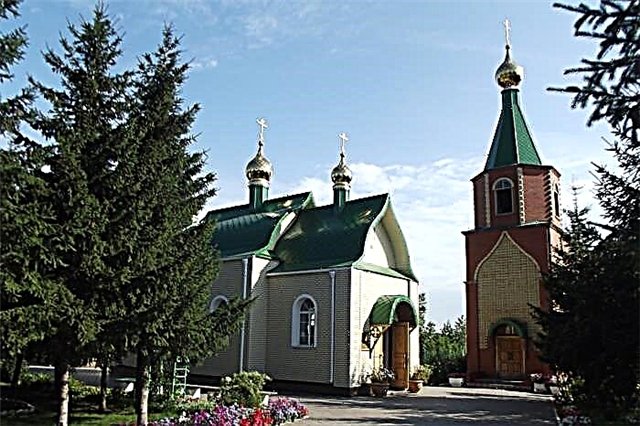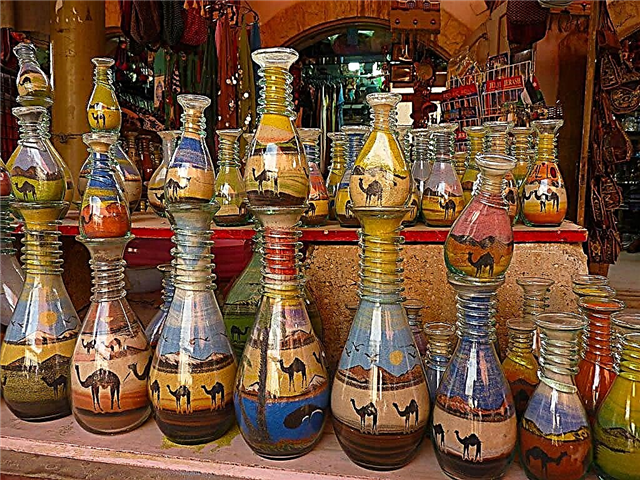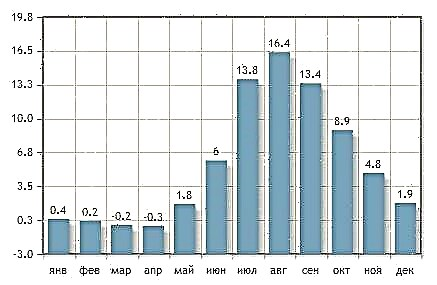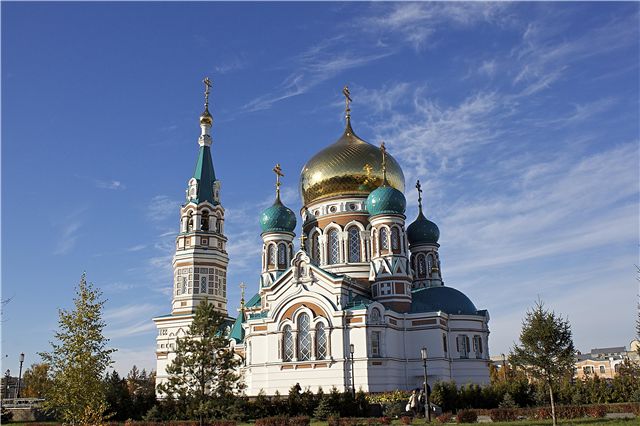Religious buildings in Omsk can amaze tourists with their diversity. Majestic and modest, modern and pre-revolutionary buildings - each temple, each church has its own unusual history. The churches of the Omsk Diocese, like many others in Russia, have gone through a stage of mass nationalization of religious buildings. Temples have gone through times of devastation, desolation and destruction.
In the 1990s, the restoration of churches and the construction of new ones began. The history of the fully restored Assumption Church, which is now the symbol of the city and its decoration, is noteworthy. Many modern churches are built according to the traditions of ancient Orthodox architecture, such as the Temple of John the Baptist or the Temple of All Saints. The temples of Omsk are interesting not only for pilgrims and believers, but also for tourists. After all, many of the temples are architectural monuments.
Operating churches and cathedrals of Omsk
List of the most famous temples in the city.
Assumption Cathedral
Historical and architectural monument, not only in Omsk, but also in Russia. Built in 1898. Then it was called the Temple of the Ascension. The project of the temple was developed by the architect Virrich based on the project of the Church of the Savior on Spilled Blood. In Soviet times, the cathedral was destroyed and then blown up. The restoration of the cathedral was completed by 2007. At night, the cathedral, incredible in its beauty, is illuminated by more than 100 lamps.
Address: Omsk, st. Tarskaya, 7
Site: omsk-sobor.ru

Nikolsky Cossack Cathedral
It was built with donations from the Siberian Cossack troops, which is why it got its name. The building of the cathedral has a rectangular shape. The entrance with columns is made in the Empire style. A green dome with a cross rises above the building. Next to it is a bell tower, which is topped with a pointed dome. The gilded iconostasis was made by Omsk carvers. The revered icons of the cathedral are the icon of St. Theodosius of Chernigov and the icon of St. Seraphim of Sarov.
Address: Lenin, 27
Site: nikolo-kazachi-sobor.ru

Holy Cross Cathedral
The second oldest temple in Omsk. Its construction was completed in 1870. Received the status of a cathedral in 1946. The snow-white cathedral impresses with its grace and is rightfully considered one of the most beautiful in Omsk. Its domes are made in turquoise color, and the three-tiered bell tower looks surprisingly lightweight. The painting on the walls of the interior is varnished. The cathedral is a historical monument of regional significance.
Address: Tarskaya, 33
Website: vozdvizhenie.prihod.ru

Church of John the Baptist
A small church was built in 2001 on the initiative and at the expense of IN Bagnyuk's widow. Before his death, he dreamed of building a chapel, and his wife fulfilled the will of her late husband. Built according to the traditions of the Orthodox churches of Russia - in white with five gilded domes. Despite his young age. the church is popular with the parishioners. Baptism ceremonies are especially often held here - this is also influenced by the name of the temple.
Address: Krasniy Put, 53

Cathedral of the Nativity of Christ
It is called the pearl of the left bank of the city of Omsk because of its grace and simplicity of forms. Located in a green park area on a small hill. Its gilded domes are visible from many points of the city. The height of the cathedral bell tower is 42 meters. Its largest bell bears the name "Leonid" after the name of the governor of Omsk, who initiated the construction of the cathedral. The church houses the largest iconostasis in the Omsk Diocese.
Address: Stepantsa, 5
Website: khristorozhdestvensky.rf

Resurrection military cathedral
It was erected in 2016 on the site of a stone church built in the 18th century and completely destroyed during the Soviet era. The restored temple almost completely repeats the original with elements of classicism and baroque. The temple is interesting for its famous parishioners. For example, F.M. Dostoevsky during his exile, the artist M.A.Vrubel was baptized there. There is a museum with an exhibition of military weapons at the temple.
Address: Spartakovskaya, 3 A

Temple of Paraskeva Friday
The church dedicated to the memory of the holy great martyr was built in 1901 on the banks of the Omi. In 1939, the temple was nationalized. They returned the churches back only in 1990. Omsk people call the church "Shkroevskaya", as the temple was built at the expense of the merchant Paraskeva Shkroeva. The style of construction is typical for Russian Orthodox churches. The building of the temple is considered an architectural and historical value, therefore it is popular not only among parishioners, but also among tourists.
Address: Kuibysheva, 1
Website: paraskeva.pravorg.ru

Nikolo-Ignatievsky temple
Built in 1915-1919. In Soviet times, the building of the temple was alternately occupied by a military warehouse and a cinema "Ekran". After the building of the temple was recognized as an architectural monument in 1989, the temple was transferred back to the ownership of the church. The condition of the building was deplorable; restoration work is still ongoing. As part of the reconstruction, in addition to repair work, a bell tower was erected, which adorned the temple.
Address: 2nd Beregovaya, 60 A

Temple of All Saints
The wooden temple was built according to the traditions of building hipped-roof temples. This is a vivid example of Russian wooden architecture. Its architecture attracts many tourists. Its appearance resembles a burning candle. The green domes of the temple are in harmony with the greenery of the Cossack Square, in which the park is located. The church has a church reading and singing school, as well as a Sunday school. Earlier on the site of the temple there was a Cossack cemetery.
Address: Kuibyshev, 75, bldg. one
Website: vsehsvyatskiy.prihod.ru

Temple of "Joy of All Who Sorrow"
It is located on the territory of the Omsk military hospital, therefore the second common name is the Hospital Church. The history of the temple began in 1825 with the construction of a wooden chapel. FM Dostoevsky came to church services when he was in the infirmary due to exacerbation of epilepsy. During the Soviet era, part of the church was demolished. The building was restored according to the only surviving photograph of 1913.
Address: Gusarov, 4, bldg. five
Site: skorb.cerkov.ru

Nikolo-Kazan Cathedral
This Orthodox cathedral was built in 1913. At that time, the staff of the temple was only 4 people - a clerk, a psalmist and 2 priests. They also taught the Word of God in the educational institutions of the city. Over the years, the gilding of the domes of the temple has turned a little black, but the cathedral itself is still very beautiful. This is the only temple in the city that survived the years of Soviet power. The cathedral is an architectural monument of regional significance.
Address: Truda, 34

Basil the Great Cathedral
The temple was built in 2000 on the basis of the building of the former kindergarten on the street. Gurtieva. The territory of the temple is located between ordinary residential buildings in a small green area. The construction was carried out at the expense of donations from parishioners. It is noteworthy that brigades of Uzbek builders living in the same microdistrict helped in the construction free of charge. The church is small, but it looks bright due to the red facades with white trim.
Address: Gurtieva, 3

Temple of the Archangel Michael
It is located at the Old-North City Cemetery. The church building was built in an atypical style in 1980-1990. It is two-story. The first floor is made of stone and contains the chapel of the Archangel Michael. The second floor was built of wood and houses the chapel of All Saints. The architect of the church project was V.A. Baranov. Parishioners note that the church has a cozy atmosphere. With a special attitude in the church they approach the rite of baptism of children.
Address: Zavertyaeva, 25

Temple "Inexhaustible Chalice"
The first in the Omsk diocese church in honor of the icon of the Mother of God "Inexhaustible Chalice" is located on the street. Mill. The decision to build the temple was made by Metropolitan Vladimir, because it is believed that this particular icon helps people cope with drug addiction and alcoholism. The construction of the temple began in 2015. The improvement of the church and the surrounding area is still ongoing, with which the parishioners help the church - both with funds and physical labor.
Address: Melnichnaya, 91 B
Site: chasha-omsk.cerkov.ru

Church of the Nativity of the Blessed Virgin
The construction of the temple began with the construction of a small chapel in 2001 on the territory of the NPO Mir. Construction lasted 3 years. However, soon, with the blessing of Vladyka Theodosius, an iconostasis was built in the chapel. The chapel got the opportunity to be called a temple. Now it hosts regular services. In 2010, by the decision of the enterprise, the premises of the church were completed and expanded due to the increase in the number of its parishioners.
Address: Zelenaya, 18, bldg. one

Church of St. John of Tobolsk
The building, which housed the "Souvenir" partnership, was transferred by the city administration to the ownership of the temple in 1992. Over the year, through the efforts of the ministers of the church and parishioners, a small one-story building was reconstructed and re-equipped for the needs of the temple. They built an iconostasis, purchased icons and bells, and erected a dome. They also equipped a library of Orthodox literature. There is a Sunday school at the church.
Address: Dimitrova, 4

Church of All Saints of Siberia
Built on the banks of the Irtysh. The construction of the temple began in 1988, in honor of the celebration of the 1000th anniversary of the Baptism of Rus. The bell tower of the temple was built separately - it is higher and has a gilded dome. A small territory of the temple is landscaped, beautiful flower beds are laid out on it. Parishioners love to come here for a homely atmosphere, which is not found in the central and large churches of the city.
Address: Omsk, Zakhlamino village, st. Narodnaya, 17

Church of St. Nicholas
Located in the Atamansky village. The temple was founded in 1911. The base of the building is made in the form of a cross. In Soviet times, the building of the church was nationalized, but the Great Patriotic War began and the building was returned back to the church in order to give people faith. The building was a cultural and educational center for only 4 years, so the interior decoration and church values did not have time to suffer.
Address: Schetinkina, 10

Church of the Savior Not Made by Hands
Built from red brick according to the project of architect M. Khakhaev. The first stone of the church was laid in 2002 before the Feast of the Savior Not Made by Hands. The foundations of the tents are decorated with kokoshniks. The dimensions of the church are small, in appearance it looks more like a chapel. In summer, its gilded domes are almost invisible due to the dense poplars planted around. There is no separate bell tower, the belfry is located on the upper tier of the church.
Address: Omsk, Mendeleev Avenue, 1/1

Church of St. George the Victorious
It is located in the park in honor of the thirtieth anniversary of the Victory. The construction of the church in 1996 is dedicated to the memory of the fallen soldiers during the Second World War, as well as to the Russian soldiers, canonized - Alexander Nevsky and Dmitry Donskoy. The architects built the building in the tradition of Orthodox architecture. The white color of the church gives the building a solemnity, the mother-of-pearl-matte domes resemble a warrior's helmet in their shape.
Address: Omsk, Suvorov, 109 bldg. one












